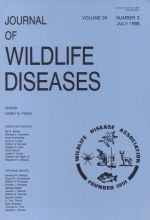Over the past 20 yr, recurrent late-summer mortality of dabbling ducks in southern Québec has been attributed to the digenean parasite Cyathocotyle bushiensis. This study attempted to determine whether this parasite was still implicated in the epizootics, and examined aspects of the ecology of the parasite in the definitive host. Comparison of prevalence and mean intensity of infection of all species of Digenea between salvaged carcasses and hunter-shot ducks revealed that C. bushiensis and a second digenean Sphaeridiotrema globulus were both significantly more prevalent in salvaged ducks. Mean intensity of infection was consistently higher for S. globulus in the salvaged carcasses than in hunter-shot ducks. These data provide strong circumstantial support for the hypothesis that C. bushiensis continues to contribute to the annual mortality, but also strongly suggest that S. globulus may be involved. Comparison of the relative numbers of each species of duck between the salvaged carcass sample and the hunter-shot sample revealed that blue-winged teal (Anas discors) occurred significantly more frequently in the salvaged carcass sample whereas wood ducks (Aix sponsa) were common in the hunter-shot sample but were never found in the salvaged carcass sample. A comparison of susceptibility to experimental infection with C. bushiensis revealed that mallards (Anas platyrhynchos), black ducks (Anas rubripes), blue-winged teal, pintail (Anas acuta) and lesser scaup (Aythya affinis) had similar susceptibilities but that wood ducks were significantly less susceptible to infection. Experimental infections also showed that age of mallards significantly influenced the number of parasites obtained 7 days postinfection; ducklings were most heavily infected. Significant differences were detected in the gross pathology caused by C. bushiensis among duck species. Data obtained from sentinel ducks placed in the field for 24 hr revealed that transmission of both C. bushiensis and S. globulus occurs at least between mid-May and mid-September and that large, potentially lethal, infections can be acquired in as little as 24 hr. Finally evidence is presented to suggest that ducks acquire resistance to challenge infections of C. bushiensis.
How to translate text using browser tools
1 July 1988
ECOLOGICAL STUDIES ON CYATHOCOTYLE BUSHIENSIS (DIGENEA) AND SPHAERIDIOTREMA GLOBULUS (DIGENEA), POSSIBLE PATHOGENS OF DABBLING DUCKS IN SOUTHERN QUÉBEC
John Hoeve,
Marilyn E. Scott

Journal of Wildlife Diseases
Vol. 24 • No. 3
July 1988
Vol. 24 • No. 3
July 1988
Cyathocotyle bushiensis
Digenea
ducks
ecology
experimental infection
parasite-induced mortality
Sphaeridiotrema globulus




